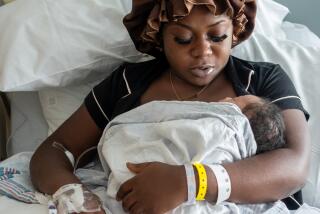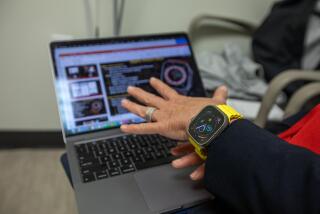Countywide : Monitoring May Prevent Early Labor
- Share via
When Dr. Martha Heppard’s labor contractions began four months before her twins were due, her choices were two: to be hospitalized for a long time or to be monitored at home.
For more than 13 weeks, Heppard stayed at home in bed with a pocket-size monitor strapped around her waist to detect any activity and an automatic syringe about the size of a credit card strapped to her thigh. The device pumped a programmed dose of medication to control early labor contractions.
Heppard, 29, a senior resident in obstetrics and gynecology at UCI Medical Center, ventured out only to visit her doctor every two weeks.
“You do go stir-crazy after awhile, but I’m very goal-oriented, so that helped to keep me sane. I thought about what I was doing for my babies in the long run,” she said. “I knew if my babies were born at this point, they would have no chance of survival.”
The twins, Matthew and Patrick, were born March 15 without complications, three weeks shy of the due date.
The monitoring system, first developed by Tokos Medical Corp. in Santa Ana in 1984, detects contractions of early labor and transmits the information to a central nursing station for evaluation. Healthdyne and CareLink Corp. have entered the Orange County market in the past three years, competing in these perinatal home-care services.
Heppard’s device was connected to a monitoring station for evaluation by nurses. If labor was suspected, Heppard was instructed and her physician notified.
“Everybody focuses on the machinery, but my gut feeling is probably the bulk of the benefit with these systems is the nurses’ input rather than the machine,” said Dr. Manuel Porto, assistant professor and director of maternal-fetal medicine at UCI Medical Center.
Porto said he uses the monitor with patients who are at extremely high risk for early labor.
“The biggest controversy about the home monitors is that it’s incredibly expensive,” he said. “At about $100 a day, patients can add up to $10,000 to the cost of their prenatal care. If it cost $5 a day, it probably wouldn’t be controversial; we’d use it on everybody. But at those costs, they’re going to have to show some significant benefit.”
Because the three Orange County companies have yet to convince the Food and Drug Administration of the monitor’s benefits, it is still labeled investigational. The label means that many insurance companies won’t cover it.
Heppard’s insurance carrier covered 80% of the $300-a-day home monitoring and therapy, a cost that could have been twice that amount if she were hospitalized, she said.
Every additional week that Heppard was able to carry the twins increased their chance of survival.
“The bed rest was very tough mentally,” Heppard said, “but it was worth it to have gotten as far as I did. “
More to Read
Sign up for Essential California
The most important California stories and recommendations in your inbox every morning.
You may occasionally receive promotional content from the Los Angeles Times.













